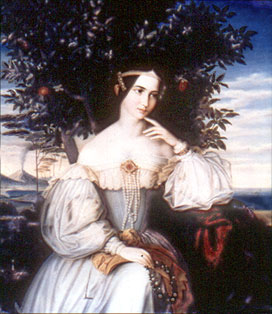Wedding
portrait of Charlotte von Rothschild
Oppenheim
received the patronage of the Rothschilds, the famous family of financiers,
philanthropists, patrons of the arts and sciences who greatly contributed
to Jewish causes; their encouragement allowed him to attain a level of
fame as a painter that would before have been impossible for a Jew. He
also worked in their service, and the domain they assigned him was that
of the "private portrait," a conventional genre of portraiture which presented
its subject as a member of the bourgeoisie and conveyed economic status.
The commissions of the Rothschilds' grand society portraits, meanwhile,
were reserved for more famous artists.
Beginning
in the late 1830s, Oppenheim took the traditional bourgeois private portrait
a step further. The Rothschilds began to require paintings that also showed
their professional credentials -- portraits hung in a bank could help
establish the image of the Jewish owner as a professional and dispel the
stereotyped image of the hated moneylender. To serve their needs, Oppenheim
invented a new genre of portrait and iconography that presented the subject's
professional image as a banker. It was Oppenheim's "banker portraits"
that earned him the title "painter of the Rothschilds."[1]
The cousins
Charlotte and Lionel de Rothschild were married in Frankfurt in 1836 with
great sumptuousness, publicity and fanfare. Their portraits, each painted
separately, reflect the couple's membership in the great banking family.
Charlotte
appears in front of a background of Mount Vesuvius that symbolized her
father's Naples bank. The background in Lionel's portrait, an English
park with medieval castle ruins in the background, symbolized his father's
London bank. Charlotte's portrait presents an opulent and graceful figure,
her gown flowing gently, her splendid jewelry painted in great detail.
The full effect is reminiscent of Botticelli's women, especially the famous
Primavera. Oppenheim consciously brings forth the aura of the Italian
Renaissance and alludes to the legendary renaissance banking family, the
Medici, to whom the Rothschilds had been frequently compared.[2]

[view enlargement]



